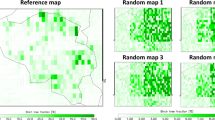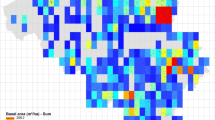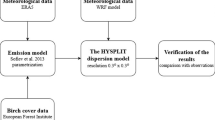Abstract
This study analyses the spatial and temporal distribution of regional and long-range transported birch (Betula L.) pollen in Lithuania and the neighbouring countries. The potential long-range transport cases of birch pollen in Lithuania were analysed for the whole period of available observations, 2004–2007. The birch pollen was recorded at three measurement stations in Lithuania by using Hirst-type volumetric spore traps. The phenological observations in Lithuania were also used for the detection of potential long-range transport-induced episodes. Two variants of the regional and continental scale atmospheric dispersion model SILAM (Lagrangian and Eulerian) in an adjoint mode (used for inverse dispersion modelling and data assimilation), and the trajectory model HYSPLIT were employed to evaluate the source origins of the observed pollen. During four seasons in 2004–2007, we found in total 24 cases, during which remarkable pollen concentrations were recorded before the local flowering season. According to modelling, most of these were originated from the sources outside Lithuania: Latvia, southern Sweden, Denmark, Belarus, Ukraine and Moldova, possibly, also coastal regions of Germany and Poland. Two episodes were attributed to local early-flowering birch trees. The spatial and temporal patterns of the long-range transport of early pollen to Lithuania were found out to be highly variable; the predicted source regions for the cases considered were similar only for some dates in 2004 and 2006. During the analysed period, we found both cases, in which the predictions of the SILAM model variants and those of the HYSPLIT model were similar, and cases, in which there were substantial differences. In general, for complicated atmospheric circulation patterns the model predictions can be drastically different, with a tendency of trajectory model to fail reproducing the key episode features.








Similar content being viewed by others
References
Bergamaschi, P., Krol, M., Dentener, F., Vermeulen, A., Meinhardt, F., Graul, R., et al. (2005). Inverse modelling of national and European CH4 emissions using the atmospheric zoom model TM5. Atmospheric Chemistry and Physics, 5, 2431–2460.
Cecchi, L., Torrigiani Malaspina, T., Albertini, R., Zanca, M., Ridolo, E., Usberti, I., et al. (2007). The contribution of long-distance transport to the presence of Ambrosia pollen in central northern Italy. Aerobiologia, 23, 145–151.
Clot, B. (2001). Airborne birch pollen in Neuchâtel (Switzerland): Onset, peak and daily patterns. Aerobiologia, 17, 25–29.
D’Amato, G., Cecchi, L., Bonini, S., Nunes, C., Annesi-Maesano, I., Behrendt, H., et al. (2007). Allergenic pollen and pollen allergy in Europe. Allergy, 62, 976–990.
Draxler, R. R., Rolph, G. D. (2003). HYSPLIT (hybrid single-particle lagrangian integrated trajectory) Model access via NOAA ARL READY Website (http://www.arl.noaa.gov/ready/hysplit4.html). NOAA Air Resources Laboratory, Silver Spring, MD. Accessed September 23, 2008.
Estrella, N., Menzel, A., Krämer, U., & Behrendt, H. (2006). Integration of flowering dates in phenology and pollen counts in aerobiology: Analysis of their spatial and temporal coherence in Germany (1992–1999). International Journal of Biometeorology, 51, 49–59.
Galperin, M. (1999). Approaches for improving the numerical solution of the advection equation. In Z. Zlatev, J. Dongarra, I. Dimov, J. Brandt, & P. J. Builtjes (Eds.), Large scale computations in air pollution modelling (pp. 161–172). The Netherlands: Kluwer Academic Publishers.
Galperin, M. V. (2000). The approaches to correct computation of airborne pollution advection. In: Problems of ecological monitoring and ecosystem modelling (Vol. XVII, pp. 54–68). St. Petersburg: Gidrometeoizdat (in Russian).
Galperin, M., Maslyaev, A., Pekar, M. & Sofiev, M. (1996). The development of HM model in 1996. MSC-E Report 5/96, Moscow, July 1996, 62.
Galperin, M., & Sofiev, M. (1998). The long-range transport of ammonia and ammonium in the Northern Hemisphere. Atmospheric Environment, 32(3), 373–380.
Gassmann, I. M., & Pérez, F. C. (2006). Trajectories associated to regional and extra-regional pollen transport in the southeast of Buenos Aires province, Mar del Plata (Argentina). International Journal of Biometeorology, 50, 280–291.
Goldberg, C., Buch, H., Moseholm, L., & Weeke, E. V. (1988). Airborne pollen records in Denmark, 1977–1986. Grana, 27, 209–217.
Hidalgo, J. P., Mangin, A., Galán, C., Hembise, O., Vázquez, M. L., & Sanchez, O. (2002). An automated system for surveying and forecasting Olea pollen dispersion. Aerobiologia, 18, 23–31.
Hirst, J. M. (1952). An automatic volumetric spore trap. Annals of Applied Biology, 39(2), 257–265.
Jato, V., Méndez, J., Rodríguez-Rajo, J., & Seijo, C. (2002). The relationship between the flowering phenophase and airborne pollen of Betula in Galicia (N.W. Spain). Aerobiologia, 18, 55–64.
Karppinen, A., Sofiev, M., Siljamo, P., Kukkonen, J., Ranta, H., Linkosalo, T., Jäger, S., Rasmunssen, A., Nicklaß, D. & Wanner, L. (2007). Pollen: A challenge for environmental information services In O. Hryniewicz, J. Studziński & A. Szediw (Eds.), EnviroInfo Warsaw 2007, environmental informatics and systems research (Vol. 2, pp. 75–79): Workshop and application papers, The 21st international conference on “informatics for environmental protection” Warsaw, Poland. Shaker Verlag: Aachen 2007, ISBN 978-3-8322-6397-3, ISSN 1616-0886.
Kasprzyk, I. (2003). Flowering phenology and airborne pollen grains of chosen tree taxa in Rzeszów (SE Poland). Aerobiologia, 19, 113–120.
Kuparinen, A. (2006). Mechanistic models for wind dispersal. Trends in Plant Science, 11, 296–301.
Kuparinen, A., Markkanen, T., Riikonen, H., & Vesala, T. (2007a). Modeling air-mediated dispersal of spores, pollen and seeds in forested areas. Ecological modelling, 208, 177–188.
Kuparinen, A., Snäll, T., Vänskä, S., & O’Hara, B. R. (2007b). The role of model selection in describing stochastic ecological processes. Oikos, 116, 966–974.
Laaidi, M. (2001). Regional variations in the pollen season of Betula in Burgundy: two models for predicting the start of the pollination. Aerobiologia, 17, 247–254.
Latałowa, M., Miętus, M., & Uruska, A. (2002). Seasonal variations in the atmospheric Betula pollen count in Gdańsk (southern Baltic coast) in relation to meteorological parameters. Aerobiologia, 18, 33–43.
Mahura, G. A., Korsholm, S. U., Baklanov, A. A., & Rasmussen, A. (2007). Elevated birch pollen episodes in Denmark: Contributions from remote sources. Aerobiologia, 23, 171–179.
Mandrioli, P., Comtois, P., Dominguez Vilches, E., Galan Soldevilla, C., Isard, S., & Syzdek, L. (1998). Sampling: Principles and techniques. In P. Mandrioli, P. Comtois, & V. Levizzani (Eds.), Methods in aerobiology (pp. 49–101). Bologna: Pitagora Editrice.
Marchuk, G. I. (1982). Mathematical modeling in the environmental problems. Moscow: “Nauka” publisher. (320 pp, in Russian).
Navasaitis, M., Ozolinčius, R., Smaliukas, D., & Balevičienė, J. (2003). Lietuvos dendroflora. Kaunas: Lututė. (575 pp, in Lithuanian).
Porsbjerg, C., Rasmussen, A., & Backer, V. (2003). Airborne pollen in Nuuk, Greenland, and the importance of meteorological parameters. Aerobiologia, 19, 29–37.
Prank, P., Sofiev, M., Kaasik, M., Ruuskanen, T., Kukkonen, J., & Kulmala, M. (2008). The origin and formation mechanics of aerosol during a measurement campaign in Finnish Lapland, evaluated using the regional dispersion model SILAM. In C. Borrego & A. I. Miranda (Eds.), Air pollution modeling and its application XIX, NATO science for peace and security series-C: Environmental security (pp. 530–538). Berlin: Springer.
Rannik, Ü., Markkanen, T., Raittila, J., Hari, P., & Vesala, T. (2003). Turbulence statistics inside and over forest: Influence on footprint prediction. Boundary-Layer Meteorology, 109, 163–189.
Ranta, H., Kubin, E., Siljamo, P., Sofiev, M., Linkosalo, T., Oksanen, A., et al. (2006). Long distance pollen transport cause problems for determining the timing of birch pollen season in Fennoscandia by using phenological observations. Grana, 45, 297–304.
Saarikoski, S., Sillanpää, M., Sofiev, M., Timonen, H., Saarnio, K., Teinilä, K., et al. (2007). Chemical composition of aerosols during a major biomass burning episode over northern Europe in spring 2006: Experimental and modelling assessments. Atmospheric Environment, 41, 3577–3589.
Sauliene, I., & Motiekaityte, V. (2005). Pecularities of aeropalinological monitoring in Northern Lithuania. The 6th international conference “environmental engineering” selected papers, I, 252–256.
Šaulienė, I., & Veriankaitė, L. (2006). Application of backward air mass trajectory analysis in evaluating airborne pollen dispersion. Journal of Environmental Engineering and Landscape Management, XIV(3), 113–120.
Šaulienė, I., Veriankaitė, L., & Lankauskas, A. (2007). The analysis of the impact of long distance air mass to airborne pollen concentration. Acta Biologica Universitatis Daugavpilensis, Suppl 1, 61–74.
Siljamo, P., Sofiev, M., Ranta, H., Linkosalo, T., Kubin, E., Ahas, R., et al. (2008a). Representativeness of point-wise phenological Betula data collected in different parts of Europe. Global Ecology and Biogeography, 17, 489–502.
Siljamo, P., Sofiev, M., Severova, E., Ranta, H., Kukkonen, J. & Polevova, S. (2008b). Sources, impact and exchange of early-spring birch pollen in the Moscow region and Finland. Aerobiologia doi:10.1007/s10453-008-9100-8.
Siljamo, P., Sofiev, M., Severova, E., Ranta, H. & Polevova, S. (2007). On influence of long-range transport of pollen grains onto pollinating seasons. In C.Borrego & E.Renner (Eds.), Developments in Environmental Science, 6. doi:10.1016/S1474-8177(70)06074-3. Air Polution Modelling and its Applications XVIII, 708–716.
Skjøth, C. A., Smith, M., Brandt, J., & Emberlin, J. (2009). Are the birch trees in Southern England a source of Betula pollen for North London? International Journal of Biometeorology, 53, 75–86.
Skjøth, A. C., Sommerw, J., Stachz, A., Smithz, M., & Brandt, J. (2007). The long-range transport of birch (Betula) pollen from Poland and Germany causes significant pre-season concentrations in Denmark. Clinical and Experimental Allergy, 37, 1204–1212.
Smith, M., & Emberlin, J. (2006). A 30-day-ahead forecast model for grass pollen in north London, United Kingdom. International Journal of Biometeorology, 50, 233–242.
Sofiev, M. (2000). A model for the evaluation of long-term airborne pollution transport at regional and continental scales. Atmospheric Environment, 34(15), 2481–2493.
Sofiev, M. (2002). Extended resistance analogy for construction of the vertical diffusion scheme for dispersion models. Journal of Geophysical Research—Atmosphere, 107, D12. doi:10.1029/2001JD001233.
Sofiev, M., Galperin, M., & Genikhovich, E. (2008a). A construction and evaluation of Eulerian dynamic core for the air quality and emergency modelling system SILAM. In C. Borrego & A. I. Miranda (Eds.), Air pollution modelling and its application XIX. NATO science for peace and security series—C: Environmental security (pp. 699–701). Berlin: Springer.
Sofiev, M., Siljamo, P., Ranta, H., Linkosalo, T., Jaeger, S. & Jaeger, C. (2008b). From Russia to Iceland: An evaluation of a large-scale pollen and chemical air pollution episode during April and May, 2006. Aerobiological Monographs, 1 (in press).
Sofiev, M., Siljamo, P., Ranta, H., & Rantio-Lehtimäki, A. (2006a). Towards numerical forecasting of long-range air transport of birch pollen: Theoretical considerations and a feasibility study. International Journal of Biometeorology, 50, 392–402.
Sofiev, M., Siljamo, P., Valkama, I., Ilvonen, M., & Kukkonen, J. (2006b). A dispersion modelling system SILAM and its evaluation against ETEX data. Atmospheric Environment, 40, 674–685.
Undén, P., Rontu, L., Järvinen, H., Lynch, P., Calvo, J. & Cats, G. et al. (2002). HIRLAM-5 scientific documentation. December 2002. SMHI: Norköping, Sweden.
Van de Water, K. P., & Levetin, E. (2001). Contribution of upwind pollen sources to the characterization of Juniperus ashei phenology. Grana, 40, 133–141.
Vogel, H., Pauling, A., & Vogel, B. (2008). Numerical simulation of birch pollen dispersion with an operational weather forecast system. International Journal of Biometeorology, 52, 805–814. doi:10.1007/s00484-008-0174-3.
WHO. (2003). Phenology and human health: Allergic disorders. WHO Regional Office for Europe: Copenhagen. 55 pp.
Acknowledgments
The authors gratefully acknowledge the assistance of NOAA Air Resources Laboratory for the HYSPLIT model help, the Lithuanian Hydrometeorological Service for the phenological data and the aerobiological networks of Finland, Denmark, Sweden and Latvia for the pollen information. The co-operation with the European Aeroallergen Network is also greatly appreciated. This study was supported by the ESA-PROMOTE, EU-HIALINE, EU-MACC and EU-MEGAPOLI projects, as well as by the COST Actions ES0603 and ES0602.
Author information
Authors and Affiliations
Corresponding author
Rights and permissions
About this article
Cite this article
Veriankaitė, L., Siljamo, P., Sofiev, M. et al. Modelling analysis of source regions of long-range transported birch pollen that influences allergenic seasons in Lithuania. Aerobiologia 26, 47–62 (2010). https://doi.org/10.1007/s10453-009-9142-6
Received:
Accepted:
Published:
Issue Date:
DOI: https://doi.org/10.1007/s10453-009-9142-6




